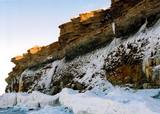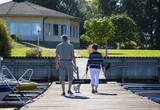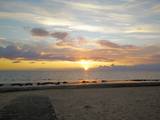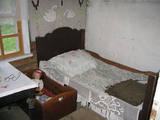| Nr | Nosaukums | Apraksts |
|---|---|---|
|
Vizuāli iespaidīgākā Baltijas valstu piekrastes klints siena (līdz 24 m augsta). Aukstās ziemās šeit veidojas fantastiski leduskritumi. Pakri bāka. |
||
|
Saimniecība “Lejaskroķi” atrodas Abavas senlejā. Tajā nodarbojas ar truškopību. Saimnieku aprūpē ir ap 500 trušu, kā arī kazas un mājputni. Viesojoties saimniecībā, viesi varēs samīļot un pabarot trusīšus, kā arī apskatīt kazlēnus, kam ļoti patīk cilvēku uzmanība. Dzīvnieciņus iespējams apskatīt, iepazīt un samīļot, kā arī pabarot. |
||
|
Tūrisma gide Ineta Jansone piedāvā ekskursijas grupām uz Ķemeriem un iepazīstina ar Ķemeru kūrorta vēsturi. Kopš seniem laikiem Ķemeri slaveni ar to, ka šeit ir daudz sērūdeņu avotu un ārstnieciskās dūņas. Šurp brauca ārstēties kopš 19. gs. sākuma. 1838. gadā Ķemeros nodibināja kūrortu. Ķemeru kūrortā ārstēja ādas un kaulu slimības, kā arī gremošanas un nervu sistēmas slimības. 1877.g. izbūvēja dzelzceļa līniju Rīga - Tukums, bet 20.gs. sākumā tika ieviesta tiešā dzelzceļa satiksme ar Maskavu. Kūrorts bija ļoti populārs un katru gadu arvien vairāk viesu brauca šurp ārstēties. Īsi pirms I Pasaules kara atklāja elektriskā tramvaja satiksmi starp Ķemeriem un jūru - Jaunķemeriem. Ķemeri atrodas starp purviem un ezeriem, 6 km attālumā no Rīgas jūras līča. |
||
|
Klusā lauku teritorijā un priežu jaunaudzes ielokā atrodas ģimenes uzņēmums ar videi draudzīgu saimniekošanas filozofiju - "LavenderVilla". Teritorijā ir izveidots lavandas lauks un lavandas labirints ar ~ 6000 lavandas stādiem. Saimniecības apmeklētājiem tiek piedāvāts iepazīties ar lavandas audzēšanu, ko izmanto dizaina priekšmetu, ēteriskās eļļas un tējas ražošanai. Papildus tiek piedāvāti naktsmītnes pakalpojumi lavandas un zāļu atpūtas namiņā, pasākumu organizēšana (joga līdzās lavandām, tematiskie pasākumi, kāzu ceremoniju vieta u.c.), pirtnieka pakalpojumi, fotografēšanās iespējas lavandas laukā un lavandas pārtikas produktu degustācijas. |
||
|
Šis ir viens no 6 ceļojuma maršrutiem sērijā "Baudi laukus!", un tas aicina apmeklēt Lauku Labumus – visdažādāko veidu un nozaru saimniecības un uzņēmumus, kas atvērti apmeklētājiem, piedāvā ekskursijas, nogaršot, apskatīt un iegādāties savus ražojumus. Tur apskatāmi mājdzīvnieki, mūsdienīgas lauku saimniecības, amatnieku darbnīcas, iegādājami lauku produkti – maize, medus, mājas vīns un alus, siers, ogas, augļi, zivis, gaļa, dārzeņi, tējas un citi laukos audzēti labumi. Pa ceļam iespējams ieturēt pusdienaslauku krodziņos. |
||
|
Talsu pienotavu dibināja 1922. gadā, apvienojot vairākas citas pienotavas. Uz šīs bāzes vēlāk izveidojās „Talsu piensaimnieks”, kura viens no pazīstamākajiem produktiem ir „Talsu rituļa” siers. „Talsu piensaimnieka” produkciju – pienu, kefīru, biezpienu, sviestu, sieru u.c. var iegādāties uzņēmumam blakus esošajā veikalā „Piena sēta”. |
||
|
Viesnīca atrodas netālu no jūras, mierīgā vidē, tikai īsa gājiena attālumā no Ekenas centra Raseborgā. Tuvumā atrodas restorāni, veikali, dzelzceļa stacija un pludmales. |
||
|
IK “55 mārītes” ir ģimenes uzņēmums Madonas novadā, kas attīsta savu darbību dabisku, Latvijā augošu ārstniecības augu tēju un garšvielu ražošanā. Uzņēmums ražo vairāk kā 70 nosaukumu monotējas (viena auga tējas), daudzzāļu tējas, ir patentējis ārstniecības augu tēju izlasi un ārstniecības augu tēju komplektu. Kopš 2014. gada ir bioloģiski sertificēts ražošanas un pārstrādes uzņēmums. Piedāvā ekskursijas grupām, kā arī meistarklases tēju gatavošanā, pazīšanā un lietošanā. |
||
|
Šajā ceļojumā apmeklēsiet gan amatnieku darbnīcas, gan zirgu audzētāju saimniecības, gan arī dažādas lauku gardumu ražotnes, kur senajām prasmēm rasts mūsdienīgs pielietojums. Pirmā pieturvieta ir Ikšķile, kur jau pašā ceļojuma sākumā apciemosiet bērzu sulu vīna pagrabu un nobaudīsiet dzirkstošu vīnu, kas darināts no bērzu sulām. Skrīveros ļaujiet sevi pārsteigt piena pārvērtībām – šeit mājīgā kafejnīcā pilsētiņas galvenajā ielā top izcils mājas saldējums gan ar zemeņu, gan anšovu un mārrutku garšu. Koknesē varat savu garderobi papildināt ar jaunu ādas jostu, somu vai stilīgu ādas rotaslietu. Kaņepju audzētāju saimniecībā neliela ekskursija un kaņepju delikateses. Latgales melnās keramikas meistaru darbi iederas arī mūsdienīgos interjeros. Aglonas maizes muzejā apmeklētājiem piedāvā pašiem izcept maizes klaipiņu, bet apmeklējums nākamajā saimniecībā ļaus papildināt to ar gardu sieru, kas siets no brīvā dabā ganītas Latvijas brūnās piena. Pēdējā pietura Latvijas pusē – Daugavpils, ar pasaulē pazīstamā abstrakcionista Marka Rotko mākslas centru un 19. gs. Daugavpils cietoksni – iespaidīgu militāro būvi kā populārākajām apskates vietām. Tālāk ceļš vedīs uz Lietuvu, kur apmeklējamas vairākas tradicionālas lauku saimniecības. Ilzenbergas muižā (Ilzenbergo Dvaras) ierīkota biodinamiskā saimniecība. Nogaršosiet lietuviešu nacionālo saldumu – šakotis, apskatīsiet Anīkšču (Anykščiai) pilsētu, kas piedāvā pastaigu taku virs kokiem. Zirgu muzejā apskatāmi senie lauksaimniecības darbarīki un tehnika. Turpinājumā viesošanās saimniecībās, kas iepazīstina ar tradicionālo lietuviešu virtuvi un podnieka amatu. Dubingu (Dubingių) zirgaudzētavā izjādes ar zirgu manēžā. Tūres nobeigumā apskatīsiet unikālo Traķu (Trakai) ezerpili (14.-15.gs.) un Viļņu. |
||
|
Altjas vēsture iestiepjas 15. gs. vidū. Altja ir sens zvejniekciems, kur jūras krastā ir apskatāmi pirms gandrīz četrdesmit gadiem atjaunotie šķūņi, kur zvejnieki glabāja tīklus un citu inventāru. Mūsdienās šķūņiem ir vairāk ainaviska vērtība, jo tie netiek izmantoti. Turpat meklējama akmeņu kaudze, kur ikviens var atstāt savu akmeni ar iedomātu vēlēšanos. Noteikti ir apmeklējams Altjas krogs (Altja kõrts) – no guļbaļķiem celta ēka ar niedru jumtu, kur var nobaudīt Igaunijas nacionālos ēdienus. Ja iepazīta Altja, var doties pārgājienā pa Oandu taku. Tai ir dažāda garuma posmi – sākot ar dažus kilometrus garo Altjas apkārtnes izziņas taku (3 km) un 0,7 km garo Bebru taku (Koprarada), līdz pat 79 km garajam vairākdienu Kirves (Kõrve) pārgājienu maršrutam. |
||
|
Viena no iespaidīgākajām Baltijas reljefa formām. Pie Siguldas tā sasniedz maksimālo dziļumu – 85 m (ap 1 km plata). Tās pievilcība ir skaistie devona perioda smilšakmens atsegumi. |
||
|
Kafejnīca "Stūrītis" atrodas Madonas centrā. Ēdienu gatavošanā izmanto augļus un dārzeņus no pašu saimniecības. Latviešu virtuve: Aukstā biešu, skābeņu un gaileņu zupa, pelēkie zirņi ar speķi, siļķe, miežu biezputra ar circeņiem, sēņu mērces, ievārījumi (septiņi veidi), visu gadu - aveņu vai zemeņu deserts. Plānās pankūkas, kas pildītas ar kartupeļiem, ķirbjiem, āboliem un rabarberiem, biezpiena plācenīši. Mājas sulas, zāļu tējas, saldējuma kokteiļi. Īpašais ēdiens: Mājas biskvīta kūka ar svaigām ogām. |
||
|
Vairāk nekā pusgadsimtu vecais dabas parks ir populārs tūrisma objekts un latviešu rakstnieces Annas Brigaderes (1861. - 1933) pasaku lugu varoņu apskates vieta. Sava mūža pēdējo desmitgadi (no 1922. līdz 1933. g.) rakstniece strādā un atpūšas Tērvetes „Sprīdīšos” (ēka uzbūvēta 1840 g.). Laikā no maija līdz oktobrim mazos apmeklētājus sagaida arī „dzīvie” pasaku tēli. Pazīstamas ir Tērvetes vecās priedes, kuru vecums sasniedzis trīs gadsimtus. Parka teritoriju caurvij takas, tādēļ šī ir piemērota vieta dažāda garuma un grūtības pastaigām. Nesen izveidots mūsdienīgs apmeklētāju centrs. |
||
|
Atrodas 1,3 km ziemeļrietumos no Aknīstes centra, nelielā Dienvidsusējas sānu gravā. Šis avots kā veselības avots pazīstams jau kopš seniem laikiem. Stāsta, ka šādu avotu, kas izplūst uz austrumiem, ūdens ir dziedinošs. Īpaši Lieldienu rītā, ja tajā mazgā acis. Avota ūdeņi satur dzelzs savienojumus, par ko liecina brūnās nogulsnes (dzelzs baktēriju darbības rezultāts). Blakus avotam ir akmens ar nelielu iedobumu, domājams – sens kultakmens. Savukārt, gravas malā aug svētliepa. Saltupju svētavotu var pamatoti uzskatīt par vienu no izcilākajiem Latvijas avotiem. Saltupju Svētavots ir ūdeņiem tik bagāts, ka izveido nelielu upīti – Saltupi, kas pēc aptuveni simts metriem ietek Dienvidsusējas upē, avots uzskatāms par vienu no garākajiem pazemes avotiem Latvijā. Tas ir vietējās nozīmes aizsargājamais kultūras piemineklis. |
||
|
Kā lielāka apdzīvota vieta Saulkrasti sāka veidoties 19. gs. beigās, kad mazie zvejniekciemi - Neibāde, Pēterupe un Katrīnbāde - kļuva par Rīgas iedzīvotāju populāru atpūtas un peldvietu. Tas strauji sekmēja vasarnīcu būvniecību. Kūrorta attīstību veicināja arī 1905. g. atklātā kuģu satiksme starp Rīgu un Saulkrastiem. Tika būvētas jaunas kūrmājas, restorāni un attīstīta cita ar kūrortu saistītā infrastruktūra. Vasaras laikā apmeklētājus izklaidēja dažādi pasākumi, balles un koncerti ar Rīgas orķestru piedalīšanos. Nākamais kūrorta attīstības veicinātājs bija 20. gs. 30. gados uzbūvētais autoceļš un dzelzceļa līnija starp Rīgu un Saulkrastiem. Padomju laiki iezīmējās ar atpūtas namiem, sanatorijām un jauniem vasaras namiņiem. Saulkrasti iegūst pilsētas statusu. Mūsdienās Saulkrasti pievilina ne tikai ar balto smilšu pludmali, bet arī ar dažādiem ikgadējiem publiskiem pasākumiem, Saulrieta taku un Balto kāpu, unikālo Saulkrastu velosipēdu muzeju, Jūras parku un peldvietu „Centrs”, Saules laukumu u.c. objektiem. |
||
|
Pļaviņās, pie Daugavas ielas, Daugavas krastā uz laukakmeņiem novietots plosta modelis ar stendu (2011. gads, biedrība „Kopsolis”), kur izlasāms stāsts ar plostnieka atmiņām un aplūkojamas vēsturiskās plostnieku fotogrāfijas. Daugavas posms starp Pļaviņām un Koknesi bija visgrūtāk pārvaramais plostnieku šķērslis ar krācēm un līdz 20 m augstiem, klinšainiem upes krastiem. |
||
|
19. gadsimta sākumā celtā dzīvojamā rija ar klona grīdu ir vecākā muzeja ēka. Dzīvojamā istaba kopā ar kambariem ir piebūvēta 19. gadsimta otrajā pusē. Turpat sētā atrodas melnā pirts, vasaras virtuve jeb paargu, klēts, pagrabs, ratnīca un ēdnīca (bijušā kūts). Ēkās ir izlikti darbarīki un kādreiz mājsaimniecībā izmantotie sadzīves priekšmeti. Pēc pasūtījuma piedāvā tradicionālus lauku ēdienus, atvērtas radošās darbnīcas. |
||
|
Kolgas muiža ar savu iespaidīgo teritoriju, daudzajām ēkām un visur jaušamo senatnes elpu neatstās vienaldzīgu! Pirmās ziņas par to ir atrodamas jau no 13. gs, taču mūsdienās redzamo pili cēla baroka stilā 17. – 18. gs., bet 19. gs. 20. gados pārbūvēja klasicisma stilā. Saimniecības ēkas ir celtas g.k. 18. – 19. gs. Laikā no 17. gs. beigām līdz 20. gs. šī bija lielākā Igaunijas muiža. Šobrīd muižas kompleksa ēkās ir iekārtota viesnīca, restorāns, konferenču centrs un muzejs. Interesenti var izmantot vietējo gidu pakalpojumus. |
||
|
Meklējams Mazā Ludzas ezera ziemeļaustrumu krastā. Muzeja brīvdabas nodaļā iepazīstama zemnieka dzīvojamā māja (dūmistaba), dzīvojamā ēka, vējdzirnavas, rija un Latgales keramiķa Polikarpa Vilcāna darbnīca. Tā teritorijā tiek organizēti ar amatniecību un dažādiem kultūras notikumiem saistīti pasākumi. Vieta, kas Latgales kultūras izziņas nolūkā, ir noteikti jāapmeklē. Blakus muzejam atrodas plosta piestātne izbraucieniem pa Mazo Ludzas ezeru (pēc iepriekšēja pieteikuma) un atpūtas vieta. |
||
|
Dabas taka atrodas Zaķumuižā un ved cauri vecajam muižas parkam, pa ceļam iespējams aplūkot simtgadīgus kokus, dažādus augus, kā arī dažādus kukaiņus, putnus. Taka ir veidota kā mācību taka un to veidojusi Zaķumuižas pamatskolas skolotāja. Taka ir 1,5 km gara. Tai ir vidējas grūtības pakāpe: takas reljefs ir samērā vienmērīgs, mērens, izņemot atsevišķus posmus (daži stāvumi un kritumi, dažviet nelīdzens reljefs), tāpēc īpaša fiziska sagatavotība pirms takas iziešanas nav nepieciešama. Vietās, kur reljefs ir stāvāks, izvietoti roku balsti, bet pāri muižas dīķu sistēmas ūdeņiem uzcelti divi tiltiņi.
|
||
























